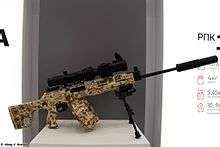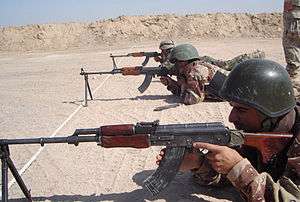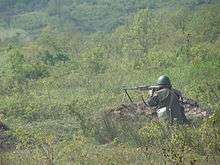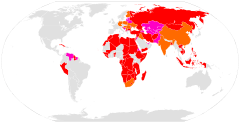RPK
The RPK (Ruchnoy Pulemyot Kalashnikova, Russian: РПК Ручной пулемёт Калашникова or "Kalashnikov hand-held machine gun") is a 7.62×39mm light machine gun of Soviet design, developed by Mikhail Kalashnikov in the early 1960s, parallel with the AKM assault rifle. It was created as part of a program designed to standardize the small arms inventory of the Soviet Army, where it replaced the 7.62×39mm RPD light machine gun. The RPK continues to be used by the armed forces of countries of the former Soviet Union and certain African and Asian nations. The RPK is also manufactured in Bulgaria, Romania and Serbia.
| RPK | |
|---|---|
 RPK with a bipod and a 75-round drum magazine | |
| Type | Light machine gun Squad automatic weapon |
| Place of origin | Soviet Union |
| Service history | |
| In service | 1961–present |
| Used by | See Users |
| Wars | Vietnam War South African Border War Yom Kippur War[1] Lebanese Civil War Angolan Civil War Afghan Wars Salvadoran Civil War Iran–Iraq War Lord's Resistance Army insurgency Tuareg rebellion (1990–1995)[2] Gulf War Yugoslav Wars Burundian Civil War[3] Iraqi conflict Syrian Civil War |
| Production history | |
| Designer | Mikhail Kalashnikov |
| Designed | 1960 |
| Manufacturer | Vyatskiye Polyany Machine-Building Plant |
| Produced | 1961–1978 |
| Variants | See Variants |
| Specifications | |
| Mass | 4.8 kg (10.6 lb) (RPK) 5.1 kg (11 lb) (RPKS) |
| Length | 1,040 mm (40.9 in) (stock extended) (RPK, RPKS) 820 mm (32.3 in) (stock folded) (RPKS) |
| Barrel length | 590 mm (23.2 in) |
| Cartridge | 7.62×39mm M43 |
| Action | Gas operated, rotating bolt; closed bolt |
| Rate of fire | 600 RPM |
| Muzzle velocity | 745 m/s (2,444 ft/s) |
| Effective firing range | 100–1,000 m sight adjustments |
| Feed system | 20-, 30-, 40-round curved magazine, 75-round drum magazine |
| Sights | Iron sights: semi-shrouded front post and rear sliding tangent with an adjustable notch Sight radius: 555 mm (21.9 in) |
Design details
Operating mechanism
The RPK functions identically to the AK-47. It also uses the same 7.62×39mm ammunition. It has a similar design layout to the Kalashnikov series of rifles, with modifications to increase the RPK's effective range and accuracy, enhance its sustained fire capability, and strengthen the receiver.[4]
Features
The RPK features a heavier and longer barrel than the AKM. This allows for the weapon to be fired for extended periods without major loss in accuracy due to the barrel heating up. The chrome-lined barrel is permanently fixed to the receiver and cannot be replaced in the field. It is fitted with a new front sight base, and the gas block lacks both a bayonet lug and an under-barrel cleaning rod guide. The barrel also features a folding bipod mounted near the muzzle, and a front sight base with a lug that limits the bipod's rotation around the axis of the barrel. The barrel has a threaded muzzle, enabling the use of muzzle devices such as flash hiders, compensators, and blank-firing adapters. When a muzzle device is not being used, the threads on the muzzle can be covered by a thread protector. The barrel is pinned to the receiver in a modified trunnion, reinforced by ribbing, and is slightly wider than the trunnion used on the standard AKM type rifles. Symmetrical bulges on both sides of the front trunnion ensure a proper fit inside the receiver.
The RPK also has a slightly longer receiver, by about 20 mm or less. This was done to decrease the fire rate slightly, but not significantly enough to lower it any less than 600 rounds per minute (RPM). The U-shaped receiver is stamped from a smooth 1.5 mm (0.06 in) sheet of steel compared to the 1.0 mm (0.04 in) sheet metal receiver used on the standard AKM rifles. It uses a modified AKM recoil spring assembly that consists of a rear spring guide rod from the AK and a new forward flat guide rod and coil spring. It features a thick laminated wood foregrip and a fixed laminated wood "club-foot" buttstock similar to the stock used on the RPD, which is designed to allow the user to fire from the prone position more comfortably. It uses a standard AKM pistol grip and can also use standard AKM detachable box magazines, but it is most commonly used with a 40-round box magazine or a 75-round drum magazine. Interchangeability of parts between the RPK and AKM are moderate.
Sights
The weapon's rear sight leaf is elevation adjustable, and graduated for ranges of 100 to 1,000 meters in 100 m increments. The rear sight leaf also features a windage adjustment knob unique to the RPK series of rifles.
Variants
RPK
The RPK is the standard light machine gun/squad automatic model and is chambered in 7.62×39mm. It was adopted by the former Soviet Union and was issued mainly to motorized units. It was later adopted by several military agencies around the world.
RPKS
The RPKS ("S" — Skladnoy (Russian: складной) means "folding" [stock]) is a variant of the RPK with a side-folding wooden stock was intended primarily for the air assault infantry. Changes to the design of the RPKS are limited only to the shoulder stock mounting, at the rear of the receiver. It uses a trunnion riveted to both receiver walls that has a socket and tang, allowing the stock to hinge on a pivot pin. The trunnion has a cut-out on the right side which is designed to engage the stock catch and lock it in place when folded. The wooden stock is mounted in a pivoting hull, which contains a catch that secures the buttstock in the extended position. The rear sling loop was moved from the left side of the stock body to the right side of the stock frame.
RPK-74
| RPK-74 | |
|---|---|
RPK-74 with a bipod | |
| Type | Light machine gun Squad automatic weapon |
| Place of origin | Soviet Union |
| Service history | |
| In service | 1974–present |
| Used by | See Users |
| Wars | Soviet–Afghan War First Chechen War Second Chechen War Russo-Georgian War War in Donbass |
| Production history | |
| Designed | 1974 |
| Produced | 1974–present |
| Specifications | |
| Mass | 4.7 kg (10 lb) (RPK-74) 4.85 kg (10.7 lb) (RPKS-74) |
| Length | 1,060 mm (41.7 in) (stock extended) (RPK-74, RPKS-74) 845 mm (33.3 in) (stock folded (RPKS-74) |
| Barrel length | 590 mm (23.2 in) |
| Cartridge | 5.45×39mm M74 |
| Action | Gas operated, rotating bolt; closed bolt |
| Rate of fire | 650 RPM |
| Muzzle velocity | 960 m/s (3,149.6 ft/s) |
| Effective firing range | 100–1,000 m sight adjustments |
| Maximum firing range | 3,150 m (3,440 yd) |
| Feed system | 30-, 45-round box magazine, 100-round plastic drum magazine, belt ammunition (with side mounted belt feed device) |
| Sights | Iron sights: semi-shrouded front post and rear sliding tangent with an adjustable notch Sight radius: 555 mm (21.9 in) |

The RPK-74 was introduced in 1974 together with the AK-74 assault rifle and chambered for the new 5.45×39mm intermediate cartridge.[5] It was derived from the AK-74 rifle, with modifications that mirror those made to the AKM to create the RPK.
The RPK-74 also uses a longer and heavier chrome-plated barrel, which has a new gas block with a gas channel at a 90° angle to the bore axis, and a ring for the cleaning rod. It is also equipped with a folding bipod and a different front sight tower. The muzzle is threaded for a flash suppressor or blank-firing device.
The rear stock trunnion was strengthened and the magazine well was reinforced with steel inserts.
Additionally, the RPK-74 has a modified return mechanism compared to the AK-74, which uses a new type of metal spring guide rod and recoil spring. The rear sight assembly, forward handguard and receiver dust cover were all retained from the RPK.
The RPK-74 feeds from a 45-round steel or polymer box magazine, interchangeable with magazines from the AK-74,[5] and is designed to be charged from stripper clips. Drum magazines similar to those used on the previous RPK models were tested during its development phase, but were discontinued in favor of the 45-round box magazine. However, recently the production of a 97-round drum has started. This drum was designed to be used with the AK-107 but can also be used in any 5.45×39mm weapon with compatible magazines, such as the RPK-74 and RPK-74M. They were also testing with experimental conventional drums, a prototype 100-round belt fed drum magazine was also created. It attaches into the regular magazine well, but the cartridges are stored on a 100-round belt inside a box. A feed system removes them from the belt and puts them in a position where they can be loaded through the regular magazine well. This system is actuated by a lever from the magazine that clips around the charging handle. It is unknown if this ever went into service.
It has a cyclic rate of fire of 650 rounds per minute (RPM).
Standard equipment includes: eight magazines, six stripper clips (15 rounds per clip), a speedloader guide, cleaning rod, cleaning kit, sling, oil bottle and two magazine pouches.[5] Some variants do not come with the cleaning kit option.
It is in widespread use by member states of the former Soviet Union, as well as Bulgaria.[5]
RPKS-74
The RPKS-74 is the paratrooper variant of the RPK-74, equipped with a wooden folding stock from the RPKS.
RPK-74M
.jpg)
The RPK-74M (Modefitsyrovannyj "Modernized") is an updated variant of the RPK-74 developed during the mid-'70s. In line with the AK-74M assault rifle variant, the RPK-74M lower handguard, gas tube cover, pistol grip, and new synthetic stock are made from a black, glass-filled polyamide. The stock is shaped like the RPK-74 fixed stock, but also side-folds like the RPKS-74. The stock additionally has an easier to use release mechanism, replacing the bullet press release from the RPKS and RPKS-74. Each RPK-74M is fitted standard with a side-rail bracket for mounting optics. It also includes most of the 74M economic changes, such as the dimpled on barrel hardware, omission of lightening cuts from the front sight block and piston and stamped gas tube release lever. Updated magazines were produced by Molot with horizontal ribs going up the sides of the magazines. An export variant chambered in 5.56×45mm NATO was also introduced, designated as the RPK-201. Also for export is the RPKM (A.K.A. RPK-203) chambered in 7.62×39mm; it uses the same polymer furniture as the RPK-74M variant.[6]
Night versions
The RPK family of light machine guns are also available in a night fighting configuration. These weapons are designated as the RPKN, RPKSN, RPK-74N, and RPKS-74N. They have a side rail mounting on the left side of the receiver that accepts a NSP-3, NSPU, or NSPUM night vision sight.[7] Models designated RPKN-1, RPKSN-1, RPK-74N and RPKS-74N can mount the multi-model night vision scope NSPU-3 (1PN51)[8] while RPKN2, RPKSN2, RPK-74N2 and RPKS-74N2 can mount the multi-model night vision scope NSPUM (1PN58).[9]
Derivatives
RPK-16

The RPK-16 5.45×39mm squad automatic weapon is a further modernization of the RPK-74. It is expected to take over the role of the RPK-74 in the Russian Armed Forces.[10] It is based on the traditional Kalashnikov layout and design, and also has several novel technical and ergonomic features derived from the AK-12 program.
The RPK-16 is chambered in 5.45×39mm cartridge and uses a Picatinny rail mounted detachable bipod instead of the fixed bipod of the RPK-74. It features the traditional Kalashnikov gas-operated long-stroke piston system, a detachable suppressor, a Picatinny rail on the top of its receiver for mounting various optics/scopes and on the bottom of the handguard for bipod mounting, an ergonomic pistol grip and a folding buttstock and two main barrel lengths; a 550 mm (21.7 in) long barrel (when it is applied or configured for the light machine gun role) and a 370 mm (14.6 in) short barrel (when it is applied or configured for the assault rifle role).[11] Its design enables it to have an interchangeable barrels, that can easily be removed. It has a combat weight of 6 kg (13.23 lb), a full length of 1,076 mm (42.4 in), a cyclic rate of fire of 700 rounds per minute (RPM), an accuracy range of 800 m (870 yd) and uses a standard 96-round drum magazine.[12] It is also compatible using magazines from the AK-74 and RPK-74.[13]
Molot Vepr
.jpg)
A series of semi-automatic rifles and shotguns based on the heavy RPK receiver are manufactured by the Molot factory in Vyatskiye Polyany, Russia. These rifles are known as the Vepr (Vepr > "Wild Boar"). They are offered in several chamberings, including: .223 Remington, 7.62×39mm, 5.45×39mm, 6.5mm Grendel, 7.62×54mmR, .308 Winchester, .30-06 Springfield and Vepr shotguns in 12 gauge, 20 gauge, and .410 bore. The hallmark of Vepr rifles is their heavy RPK receiver and barrel. The barrel, gas block, and bore are chrome lined throughout. They are intended for the civilian market, and are marketed as high quality hunting rifles. Due to this designation, they lack features seen on most AK type rifles. Vepr rifles do not include a bayonet lug, integrated cleaning rods or tool kits, can not accept standard AK magazines, and have wooden thumb-hole stocks. Some buy these rifles to "convert" into a traditional style AK rifle, installing new pistol-grip stocks and adding tactical accessories.
Early generations of the Vepr rifle were manufactured with slant-back receivers, making them incompatible with most AK furniture sets without a converter. The receivers were changed to straight-back in the second generation. Subsequent versions of the rifle reverted to slant-back. Due to this rapid change between designs, it is not uncommon to find some second generation Vepr rifles with rough, incomplete stocks that have not been sanded or painted.
Users












































RPK-74: Limited usage by airborne forces, last known RPK-74s were withdrawn from service in 2005 with Tantals.
















Former users


.svg.png)
See also
- ČZW-762
- Nikonov machine gun
- IP-2
- Valmet M78
- Zastava M77
References
- David Campbell (2016). Israeli Soldier vs Syrian Soldier : Golan Heights 1967–73. Combat 18. illustrated by Johnny Shumate. Osprey Publishing. p. 78. ISBN 9781472813305. Archived from the original on 2018-09-30. Retrieved 2018-09-30.
- Small Arms Survey (2005). "Sourcing the Tools of War: Small Arms Supplies to Conflict Zones" (PDF). Small Arms Survey 2005: Weapons at War. Oxford University Press. p. 166. ISBN 978-0-19-928085-8. Archived from the original on 2018-08-30. Retrieved 2018-08-29.
- Small Arms Survey (2007). "Armed Violence in Burundi: Conflict and Post-Conflict Bujumbura" (PDF). The Small Arms Survey 2007: Guns and the City. Cambridge University Press. p. 204. ISBN 978-0-521-88039-8. Archived from the original on 2018-08-27. Retrieved 2018-08-29.
- Marco Vorobiev (15 June 2016). Gun Digest Shooter's Guide to AKs. Krause Publications. pp. 239–. ISBN 978-1-4402-4641-8.
- https://www.tactical-life.com/firearms/rifles/russian-rpk-74-gun/
- Modern Firearms' RPK Page. Archived 2007-07-01 at the Wayback Machine Retrieved on September 10, 2008.
- RPK-74N2 Light Machine Gun (1974). Archived 2008-09-26 at the Wayback Machine Retrieved on September 10, 2008.
- ИЗДЕЛИЕ 1ПН51 ТЕХНИЧЕСКОЕ ОПИСАНИЕ И ИНСТРУКЦИЯ ПО ЭКСПЛУАТАЦИИ [PRODUCT 1PN51 TECHNICAL DESCRIPTION AND OPERATING INSTRUCTIONS] (in Russian). January 1992. pp. 11, 16.
- ИЗДЕЛИЕ 1ПН58 ТЕХНИЧЕСКОЕ ОПИСАНИЕ И ИНСТРУКЦИЯ ПО ЭКСПЛУАТАЦИИ [PRODUCT 1PN58 TECHNICAL DESCRIPTION AND OPERATING INSTRUCTIONS] (in Russian). February 1991. pp. 5, 13.
- Sputnik. "Sniper Machinegun: Kalashnikov Unveils Universal Weapon for Special Forces". sputniknews.com. Archived from the original on 2017-03-05. Retrieved 2017-03-14.
- "Army 2016: Kalashnikov unveils RPK-16 LMG | IHS Jane's 360". www.janes.com. Archived from the original on 2017-03-15. Retrieved 2017-03-14.
- "RPK-16 light machine gun - Modern Firearms". Modern Firearms. 2016-09-01. Archived from the original on 2018-06-24. Retrieved 2018-06-21.
- Sputnik. "Sniper Machinegun: Kalashnikov Unveils Universal Weapon for Special Forces". sputniknews.com. Archived from the original on 2017-03-05. Retrieved 2017-03-05.
- Jones, Richard D. Jane's Infantry Weapons 2009/2010. Jane's Information Group; 35 edition (January 27, 2009). ISBN 978-0-7106-2869-5.
- http://i50.photobucket.com/albums/f301/kagemushamu/SmallArms01/SmallArms01-001.jpg
- "Arsenal's LMG Page, 7.62 x 39 mm". Arsenal. Archived from the original on 2012-02-12. Retrieved 2010-04-06.
- "Arsenal's LMG Page, 5.56 x 45 mm". Arsenal. Archived from the original on 2012-02-12. Retrieved 2010-04-06.
- "Arsenal's LMG Page, 5.45 x 39 mm". Arsenal. Archived from the original on 2012-02-12. Retrieved 2010-04-06.
- "Grenade attack kills three Burundi ruling party members". africanews. Reuters. 2017-05-18. Archived from the original on 2017-07-05. Retrieved 2017-06-25.
- "Small Arms Survey - Working Papers" (PDF). 8 November 2012. Archived (PDF) from the original on 4 July 2010. Retrieved 16 November 2014.
- "Rosyjska broń dla Fidżi" (in Polish). altair.pl. Archived from the original on 2016-03-04. Retrieved 2016-02-21.
- "Archived copy". Archived from the original on 2017-11-07. Retrieved 2017-10-30.CS1 maint: archived copy as title (link)
- ITAR-TASS Photo Agency (2008-08-14). "South Ossetian capital in ruins". alamy.com. Archived from the original on 2017-08-09. Retrieved 2017-08-09.
- "Ghana Armed Forces Denies Robbery Allegation". exposeGHANA.com. Archived from the original on 9 November 2014. Retrieved 16 November 2014.
- "Archived copy". Archived from the original on 2013-10-19. Retrieved 2013-10-18.CS1 maint: archived copy as title (link)
- "APPLY NOW! Ghana Armed Forces Commences 2013 Recruitment Process". exposeGHANA.com. Archived from the original on 17 December 2014. Retrieved 16 November 2014.
- "Al Quds RKKS (AKM) Machine Rifle". awm.gov.au. Australian War Memorial. Archived from the original on 2018-12-07. Retrieved 2018-12-07.
- Small Arms Survey (2008). "A Semi-automatic Process? Identifying and Destroying Military Surplus" (PDF). Small Arms Survey 2008: Risk and Resilience. Cambridge University Press. p. 99. ISBN 978-0-521-88040-4. Archived from the original on 2018-08-30. Retrieved 2018-08-30.
- Berman, Eric G. (March 2019). Beyond Blue Helmets: Promoting Weapons and Ammunition Management in Non-UN Peace Operations (PDF). Small Arms Survey/MPOME. p. 43.
- Thompson, Leroy (December 2008). "Malaysian Special Forces". Special Weapons. Archived from the original on 2012-02-19. Retrieved 2010-02-10.
- "Namibia receives Russian small arms". defenceweb. 1 June 2016. Archived from the original on 2 June 2016. Retrieved 30 June 2016.
- Fabrica de Arme Cugir SA's LMG Page. Archived 2007-12-16 at the Wayback Machine Retrieved on September 10, 2008.
- Fabrica de Arme Cugir SA's LMG Md. 1993 Page. Archived 2008-02-10 at the Wayback Machine Retrieved on September 10, 2008.
- Small Arms Survey (2006). "Fuelling Fear: The Lord's Resistance Army and Small Arms" (PDF). Small Arms Survey 2006: Unfinished Business. Oxford University Press. p. 283. ISBN 978-0-19-929848-8. Archived from the original on 2018-08-30. Retrieved 2018-08-29.
- Galeotti, Mark (27 Jun 2019). Armies of Russia's War in Ukraine. Elite 228. Osprey Publishing. pp. 20, 48, 60. ISBN 9781472833440.
- "NVA". Archived from the original on 30 January 2013. Retrieved 16 November 2014.
Further reading
- Юрий Пономарёв "Битва трёх «К»", Kalashnikov magazine, 2010/6, pp. 76–85 (in Russian, covers the design competition)
External links
| Wikimedia Commons has media related to RPK. |
| Wikimedia Commons has media related to RPK-74. |

